The 77th Annual Meeting of Advisory Trustees and Board of Directors of Southwest Research Institute scheduled for February 17, 2025, will feature presentations on key SwRI research programs conducted during the 2024 fiscal year. Contact Robert Crowe, +1 210 522 4630 or Joanna Quintanilla, +1 210 522 2073 for more information or to interview the researchers.
Press release: SwRI Celebrates 77th Annual Meeting
Presentations
The role of hydrogen in a sustainable future
In 2024, SwRI unveiled a hydrogen-fueled Class 8 demonstration vehicle, developed through its industry-supported H2-ICE consortium. The demonstration vehicle features a hydrogen internal combustion engine (H2-ICE) that produces ultra-low NOx and CO2 emissions while still providing enough torque and power required for heavy-duty truck. The H2-ICE demo vehicle incorporates existing technology into its design, which may provide a timely and viable pathway to decarbonize the long-haul trucking industry.
Related links:
SwRI-led H2-ICE Consortium demonstrates ultra-low emissions with hydrogen-fueled heavy-duty engine
Related videos:
Test driving the H2-ICE demo truck
Hydrogen Internal Combustion Engine (H2-ICE) Consortium
For more information, visit Hydrogen internal combustion engine H2-ICE Consortium or Hydrogen Energy Research.
Ryan Williams, manager, Powertrain Engineering Division
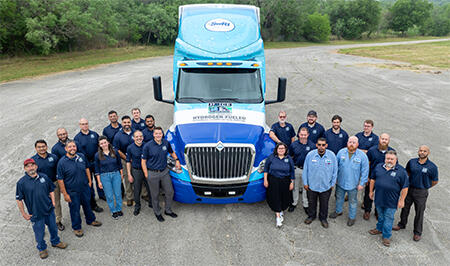
Courtesy of SwRI
The H2-ICE development team posed with a newly unveiled hydrogen internal combustion engine demonstration vehicle in May of 2024. Developed through the H2-ICE consortium, the demo truck integrates existing vehicle technology with hydrogen fuel to create a faster pathway to decarbonization.
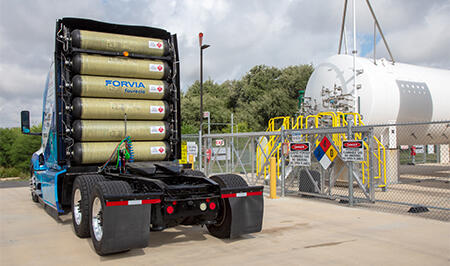
Courtesy of SwRI
The SwRI-led H2-ICE consortium developed and integrated an internal combustion engine powered by hydrogen into a Class 8 truck. The H2-ICE vehicle provides the power and torque required for long-haul trucking while achieving near-zero NOx and CO2 emissions.
QuickSounder: NOAA’s next-gen environmental monitoring satellites
SwRI is developing QuickSounder, the first in a new generation of NOAA low-Earth orbit environmental satellites, in a fraction of the time and cost of previous systems. NASA selected SwRI to fast-track the development of the satellites over three years, starting in 2024. QuickSounder is part of a collaborative mission between NASA and NOAA through NOAA’s Near-Earth Orbit Network (NEON) program.
Related Links:
SwRI awarded $54 million dollar contract to develop QuickSounder weather satellite
Technology Today Podcast episode 69: QuickSounder Environmental Satellite
For more information, visit Space Engineering.
Keith Smith, director, Space Science Division
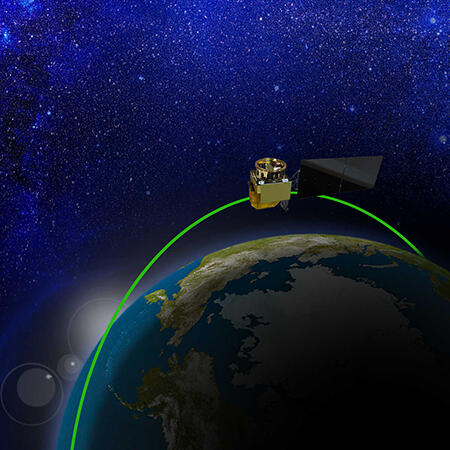
Courtesy of SwRI
Funded by a $54 million contract with NASA and NOAA, the SwRI-designed QuickSounder will be the first in a new generation of NOAA low-Earth orbit environmental satellites.
Introducing artificial intelligence
SwRI has been using artificial intelligence for decades, but the prevalence of large language models has changed the game a bit. This presentation discusses best ways to use LLMs to boost productivity, provide insights, brainstorm and enhance communication. SwRI also discusses SwRI’s LLM Adoption for Multiple Purposes (LAMP) research initiative, which is using internal research funding on more than a dozen projects aimed at harnessing LLMs for everything from faster drug design to automation.
Related video:
Large Language Models: The Promise, the Perils and the Path Forward
For more information, visit Machine Learning Technologies.
Lynne Randolph, institute engineer, Intelligent Systems Division

Courtesy of SwRI
The LLM Adoption for Multiple Purposes (LAMP) research initiative explores novel uses of LLM technology through internal research funding.
Byte-sized miracles: How AI is revolutionizing healthcare
Over the last decade, SwRI’s cutting-edge artificial intelligence research has advanced and supported medical providers by improving how they detect, diagnose and treat various diseases. SwRI is taking a patient-centered approach to create fair, trustworthy, actionable and secure tools to support healthcare, from environmental exposure risks to maternal health. SwRI also is helping the military evaluate risks and benefits to its troops and to help modernize holistic health support with an app, one “byte” at a time.
Related links:
SwRI-UT Health San Antonio researchers win automated cancer detection challenge
SwRI develops novel DNA targeting therapeutic screening technique
For more information, visit Bioinformation Data Analysis Services.
Prativa Hartnett, research computer scientist, Intelligent Systems Division
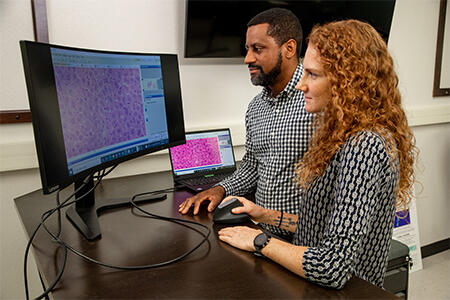
Courtesy of SwRI
SwRI’s Donald Poole and Dr. Courtney Rouse adapt machine learning algorithms to identify problematic cells in lymphoma samples to help clinicians assess new polyploid suppression therapies. Chemotherapy-induced polyploid cells become resistant to additional bouts of chemotherapy.
Detection and prevention of traumatic brain injuries
Diagnosing traumatic brain injuries currently requires a physician and a battery of tests including CT and MRI scans, but a new technique under development could change that. Researchers from SwRI and The University of Texas at San Antonio (UTSA) are developing a technique to detect traumatic brain injury (TBI) through breath analysis. Supported by a $125,000 grant from the Connecting through Research Partnerships (Connect) program, researchers are working to identify specific biomarkers such as metabolites and proteins in breath that correlate with traumatic brain injury.
Related links:
SwRI-UTSA collaborate to detect traumatic brain injury through breath analysis
For more information, visit Biomedical Health.
Dr. Mark Libardoni, staff scientist, Space Science Division
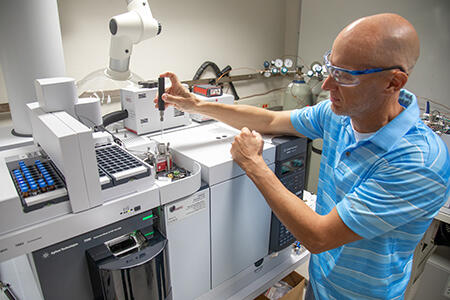
Courtesy of SwRI
Researchers at SwRI and UTSA, supported by a $125,000 grant, are working to advance breath analysis techniques to identify traumatic brain injuries
AMMO toolkit
SwRI developed the Advanced Military Measure of Olfaction (AMMO) smell test to screen patients for traumatic brain injuries in minutes. The kit consists of several vials and a variety of scents designed for use in combat zones and football fields alike. Studies show failure to correctly identify the scents highly correlates with a TBI diagnosis through MRI. The screening tool can identify patients needing additional medical attention and testing.
Related links:
SwRI develops screening tool for traumatic brain injuries
Technology Today Podcast episode 73: Targeting TBI
For more information, visit Biomedical Devise Design.
Kreg Zimmern, senior research engineer, Chemistry and Chemical Engineering Division
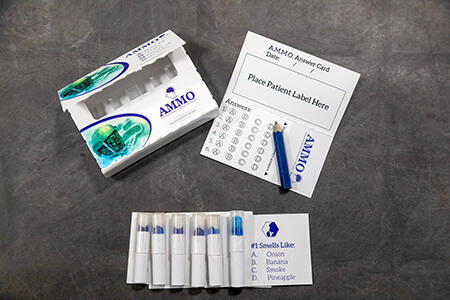
Courtesy of SwRI
SwRI developed the Advanced Military Measure of Olfaction (AMMO), a smell test consisting of six scents that can help screen for traumatic brain injuries in minutes.
Helmet pads development
SwRI and UTSA are collaborating to develop helmets with multi-functional padding that responds differently depending on the type of impact the wearer experiences. During a blunt impact such as a fall, the padding softens to cushion against the blow. In contrast, ballistic impacts from shrapnel or bullets cause the padding to stiffen to absorb the impact’s kinetic energy and prevent injury to the skull and brain.
Related links:
SwRI-UTSA developing helmet pads reduce traumatic brain injury military service members
Technology Today Podcast episode 73: Targeting TBI
Related video:
For more information visit, the Helmet Testing Laboratory.
Dr. Daniel Portillo, research engineer, Mechanical Engineering Division

Courtesy of SwRI
Supported by a $125,000 Connecting through Research Partnerships grant, UTSA’s Dr. Morteza Seidi, left, and Southwest Research Institute's Dr. Daniel Portillo along with co-principal investigators Dr. Marzieh Memar and Dr. Daniel Nicolella (not pictured) are developing multi-functional helmet padding to help prevent traumatic brain injuries a variety of settings.
Osteoporosis: the silent enemy
Bone loss caused by aging effects millions each year, with half of women over the age of 55 suffering from some sort of fracture in their lifetime. If medical providers can determine which patients are most at risk, they can offer preventative measures to help patients strengthen their bones and ward off breaks. SwRI-developed a technology to predict osteoporotic fracture by training an artificial intelligence model with super-resolution technology, to enhance raw images, such as X-rays and CT scans. The higher-resolution images help accurately predict the internal structure of bones to give doctors a tool for determining which patients require preventative care to improve their bone health.
For more information, visit Biomechanics and Human Performance.
Dr. Lance Frazer, senior research engineer, Mechanical Engineering Division
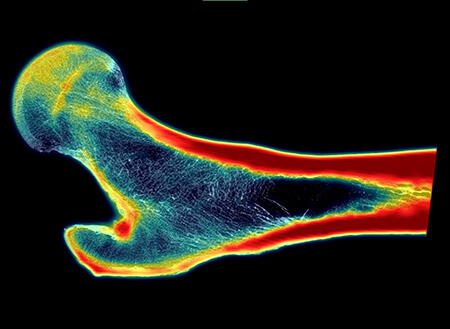
Courtesy of SwRI
SwRI developed a technique for processing raw images of bones to predict their microstructure to help doctors identify which patients are at-risk for fractures.
